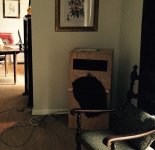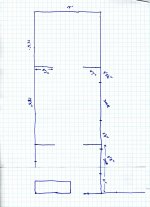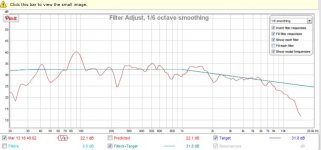The point of a "corner speaker" is that they are "corner loaded." In other words, the walls that form the corner of the room become an extension of the speaker cabinet itself (which is quite often a rear-mouthed back-loaded horn. The corner becomes a very large extension of the horn in this case.
The crossovers are irrelevant with respect to corner loading. It would be easy enough to build a corner loaded speaker that has no crossover at all (single fullrange driver).
The crossovers are irrelevant with respect to corner loading. It would be easy enough to build a corner loaded speaker that has no crossover at all (single fullrange driver).
When a speaker is sitting in the free field, say 3 ft from the front wall and 3 ft from the side wall, it is radiating sound in all directions, at least until the size of woofer becomes larger than the wavelength of the frequency it is radiating. You get reflections from the side walls and the front walls. With a corner speaker, there is no radiation going to the back. As a result, there is usually a boost in the bass frequencies. The side wall (at least the near side wall) reflection is eliminated and the front wall reflection is eliminated. The ceiling and floor reflection is still there. If I were to rank reflections in the order in which they color the sound, floor and ceiling would be first, followed by front, and last would be the side reflections. The corner arrangement gets rid of the front wall reflection and that can be a big plus.
So, you have bass boost and the elimination of some reflections. That being said, I would suggest most commercial manufacturers are looking towards the benefit from the bass boost only. Klipsch also probably uses the corner as a horn to match directivity with the HF horn. Not sure there is any difference in designing the crossover.
You don't need any special cabinet design to use the bass boost. Just stick it in the corner and by virtue of the radiation going to a 2pi space, you will see an increase in efficiency.
So, you have bass boost and the elimination of some reflections. That being said, I would suggest most commercial manufacturers are looking towards the benefit from the bass boost only. Klipsch also probably uses the corner as a horn to match directivity with the HF horn. Not sure there is any difference in designing the crossover.
You don't need any special cabinet design to use the bass boost. Just stick it in the corner and by virtue of the radiation going to a 2pi space, you will see an increase in efficiency.
OK, well... thanks for the responses.
I am aware of what happens outside the speaker. But am still confused as to what the difference is between a speaker with very similar cabinets where one speaker reacts very well to the corner and the other speaker doe not.
I lived with a 15" DC Tannoy that had a horrible response in the corner and currently have a 2 way w a very similar cabinet (dimension and size) that measures and sounds great in the corner.
I am aware of what happens outside the speaker. But am still confused as to what the difference is between a speaker with very similar cabinets where one speaker reacts very well to the corner and the other speaker doe not.
I lived with a 15" DC Tannoy that had a horrible response in the corner and currently have a 2 way w a very similar cabinet (dimension and size) that measures and sounds great in the corner.
The Tannoy probably has a half space tuning to maximize its [mid]bass output, i.e. be tonally ~ flat placed either well away from any wall whereas the other speaker may not have much/any baffle step compensation.
In short, down low, the room's acoustics dominate, so for a tonally balanced response down into the bass requires the speaker system's response account for this extra gain if placed near/at a wall or corner.
GM
In short, down low, the room's acoustics dominate, so for a tonally balanced response down into the bass requires the speaker system's response account for this extra gain if placed near/at a wall or corner.
GM
A corner speaker will not only boost the bass but boost certain frequencies preferentially as it will fully excite both room length and breadth. Of course you can compensate for such resonances but this won't work for all listening positions as for every peak there will be a trough. The result is really a function of the listening position and room acoustics rather than the speaker design, although if a speaker can somehow re-absorb these standing waves then it will improve matters. Some ported designs will tend to do this by the absorptive material in the enclosure. Generally corner positioning is to be avoided though.
The Tannoy probably has a half space tuning to maximize its [mid]bass output, i.e. be tonally ~ flat placed either well away from any wallwhereas the other speaker may not have much/any baffle step compensation.
In short, down low, the room's acoustics dominate, so for a tonally balanced response down into the bass requires the speaker system's response account for this extra gain if placed near/at a wall or corner.
GM
GM, So glad you stepped in, I was hoping you would.
"The Tannoy probably has a half space tuning to maximize its [mid]bass output"
I can tell you the Tannoy's had prodigious Mid Bass energy.
"has a half space tuning".... "be tonally ~ flat"..."speaker system's response account for this extra gain if placed near/at a wall or corner."
How is that actually engineered?
Here's where I am going with this:
I know things aren't perfect and the xover needs to be tweaked and cabinet resonance needs to be tamed a bit. But before I keep going down that path... I am thinking about experimenting with a "new" cabinet. Slightly more volume and slightly less deep. I want to see if I can get some of the energy and dynamics derived from a stiff but thinner walled speaker, ala. Shindo, Harbeth, Audio Note.
My drivers are Altec 802B, 32b horn, Jensen 15" Pll. Current cabinet is 3/4 inch Baltic Birch. Exterior dimensions are 20"wide, 17"deep, 39 3/4" tall. No bracing with carpet backing on the "back" wall opposite the drivers.
Attached is a measurement from the corners which is the only place I could get decent response out of these speakers. I have half walls as you can see in the pictures.
GM- I live not far from you. Ever come to Athens? Please stop by should you be in the neighborhood. I would love to discuss all things vintage, especially Altec.
Attachments
Greets!
Designing for room/boundary gain is done by using cab net volume [Vb], internal damping and tuning [Fb] to adjust the bass roll off slope.
For half space, you either need to do it acoustically with a BLH or additional drivers to tonally balance the lows to highs or use EQ to shelve down the mids/HF to match up with the bass.
What are the P15LL’s specs? A < 6 ft^3 cab seems way too small for it and could at least partly explain the big bump in the 80-100 Hz BW.
Way back when, 10 ft^3 was the factory recommendation.
Thanks for the invite! I can’t recall going to Athens since combining business with dating some ‘Clarke Co. Country Club’ co-eds back in the mid ‘60s and the farthest I normally drive these days is ~22 mi. round trip to Smyrna.
GM
Designing for room/boundary gain is done by using cab net volume [Vb], internal damping and tuning [Fb] to adjust the bass roll off slope.
For half space, you either need to do it acoustically with a BLH or additional drivers to tonally balance the lows to highs or use EQ to shelve down the mids/HF to match up with the bass.
What are the P15LL’s specs? A < 6 ft^3 cab seems way too small for it and could at least partly explain the big bump in the 80-100 Hz BW.
Way back when, 10 ft^3 was the factory recommendation.
Thanks for the invite! I can’t recall going to Athens since combining business with dating some ‘Clarke Co. Country Club’ co-eds back in the mid ‘60s and the farthest I normally drive these days is ~22 mi. round trip to Smyrna.
GM
- Status
- This old topic is closed. If you want to reopen this topic, contact a moderator using the "Report Post" button.
- Home
- Loudspeakers
- Full Range
- What makes a "corner speaker" behave advantageous in a corner


